Baseline Measurements of Waves and Currents along the Coast of Oman
Abstract
:1. Introduction
2. Materials and Methods
3. Results and Discussion
3.1. Wave Measurements
Wave Height Return Period Analysis
3.2. Tide and Current Measurements
4. Conclusions
Author Contributions
Funding
Institutional Review Board Statement
Informed Consent Statement
Data Availability Statement
Acknowledgments
Conflicts of Interest
References
- Chitrakar, P.; Baawain, M.S.; Sana, A.; Al-Mamun, A. Current Status of Marine Pollution and Mitigation Strategies in Arid Region: A Detailed Review. Ocean Sci. J. 2019, 54, 317–348. [Google Scholar]
- Chitrakar, P.; Baawain, M.S.; Sana, A.; Al-Mamun, A. Multivariate statistical technique in the assessment of coastal water quality of Oman. J. Environ. Eng. Sci. 2020, 15, 141–153. [Google Scholar]
- Reynolds, R.M. Physical Oceanography of the Gulf, Strait of Hormuz, and the Gulf of Oman-Results from the Mt Mitchell Expedition. Mar. Pollut. Bull. 1993, 27, 35–59. [Google Scholar]
- Akbari, P.; Sadrinasab, M.; Chegini, V.; Siadatmousavi, M. Tidal Constituents in the Persian Gulf, Gulf of Oman and Arabian Sea: A Numerical Study. Indian J. Geo-Mar. Sci. 2016, 45, 1010–1016. [Google Scholar]
- Ketabdari, M.J.; Ilia, A.; Karimi, M. A Model Study of Wind-Induced Sea Level Fluctuations in the Persian Gulf and the Gulf of Oman. In Proceedings of the International Conference on Numerical Analysis and Applied Mathematics (ICNAAM 2014), Rodhes, Greece, 22–28 September 2014; American Institute of Physics, Ed.; American Institute of Physics (AIP): College Park, MD, USA, 2014; Volume 1648, p. 770010. [Google Scholar]
- U.S. Energy Information Administration. Available online: https://www.eia.gov/todayinenergy/detail.php?id=4430 (accessed on 20 July 2023).
- Kwarteng, A.Y.; Al-Hatrushi, S.M.; Illenberger, W.K.; McLachlan, A.; Sana, A.; Al-Buloushi, A.S.; Hamed, K.H. Beach erosion along Al Batinah coast, Sultanate of Oman. Arab. J. Geosci. 2016, 9, 85. [Google Scholar]
- Sana, A.; Baawain, M. Assessment of seawater quality along northern coast of Oman. In Proceedings of the 6th International Conference on Asian and Pacific and Coasts (APAC 2011), Hong Kong, 14–16 December 2011; pp. 2002–2009. [Google Scholar]
- Pous, S.P.; Carton, X.; Lazure, P. Hydrology and circulation in the Strait of Hormuz and the Gulf of Oman—Results from the GOGP99 Experiment: 1. Strait of Hormuz. J. Geophys. Res. 2004, 109, C12037. [Google Scholar] [CrossRef]
- Pous, S.P.; Carton, X.; Lazure, P. Hydrology and circulation in the Strait of Hormuz and the Gulf of Oman—Results from the GOGP99 Experiment: 2. Gulf of Oman. J. Geophys. Res. 2004, 109, C12038. [Google Scholar]
- Bruss, G.; Kwarteng, A.; Baawain, M.; Sana, A.; Chitrakar, P.; Al-Abdali, F.; Al-Habsi, H. Coastal Currents on the Northern Omani Shelf. In Proceedings of the 13th International Conference on Coasts, Ports and Marine Structures (ICOPMAS 2018), Tehran, Iran, 26–28 November 2018. [Google Scholar]
- Lee, W.; Kaihatu, J.M. Effects of Desalination on Hydrodynamic Process in Persian Gulf. Coast. Eng. Proc. 2018, 1, 3. [Google Scholar]
- Elhakeem, A.; Elshorbagy, W. Hydrodynamic evaluation of long term impacts of climate change and coastal effluents in the Arabian Gulf. Mar. Pollut. Bull. 2015, 101, 667–685. [Google Scholar]
- Chitrakar, P.; Baawain, M.S.; Sana, A.; Al-Mamun, A. Hydrodynamic measurements and modeling in the coastal regions of Northern Oman. J. Ocean Eng. Mar. Energy 2020, 6, 99–119. [Google Scholar]
- Rakha, K.; Al-Salem, K.; Neelamani, S. Hydrodynamic Atlas for the Arabian Gulf. J. Coast. Res. 2007, Special Issue 50, 550–554. [Google Scholar]
- Kämpf, J.; Sadrinasab, M. The circulation of the Persian Gulf: A numerical study. Ocean Sci. 2006, 2, 27–41. [Google Scholar] [CrossRef]
- Singer, M.N.; Cavalcante, G.H.; Atabay, S. Hydrodynamic modeling of Sharjah lagoons under climate changes, United Arab Emirates (UAE). Reg. Stud. Mar. Sci. 2023, 63, 102995. [Google Scholar]
- Azam, M.H.; Elshorbagy, W.; Ichikawa, T.; Terasawa, T.; Taguchi, K. 3D Model Application to Study Residual Flow in the Arabian Gulf. J. Waterw. Port, Coastal, Ocean Eng. 2006, 132, 388–400. [Google Scholar]
- Azam, M.H.; Elshorbagy, W.; Nakata, K. Three-Dimensional Modeling of the Ruwais Coastal Area of United Arab Emirates. J. Waterw. Port, Coastal, Ocean Eng. 2006, 132, 487–495. [Google Scholar] [CrossRef]
- Elshorbagy, W.; Azam, M.H.; Taguchi, K. Hydrodynamic Characterization and Modeling of the Arabian Gulf. J. Waterw. Port, Coastal, Ocean Eng. 2006, 132, 47–56. [Google Scholar]
- Elhakeem, A.; Elshorbagy, W.; Bleninger, T. Long-term hydrodynamic modeling of the Arabian Gulf. Mar. Pollut. Bull. 2015, 94, 19–36. [Google Scholar] [CrossRef]
- Abdulla, K.H.; Naser, H.A. Protection of marine environmental quality in the Kingdom of Bahrain. Ocean Coast. Manag. 2021, 203, 105520. [Google Scholar] [CrossRef]
- Madah, F.; Gharbi, S.H. Numerical simulation of tidal hydrodynamics in the Arabian Gulf. Oceanologia 2022, 64, 327–345. [Google Scholar] [CrossRef]
- Ramesh, M.; Krishna, P.S.; Raj, V.A.; Nair, L.S. Coupled coastal monitoring framework for the analysis of beach stability and nearshore hydrodynamics of a structure influenced medium energy coast in India. Ocean Coast. Manag. 2023, 239, 106619. [Google Scholar] [CrossRef]
- Rhomad, H.; Khalil, K.; Neves, R.; Sobrinho, J.; Dias, J.M.; Elkalay, K. Three-dimensional hydrodynamic modelling of the Moroccan Atlantic coast: A case study of Agadir bay. J. Sea Res. 2022, 188, 102272. [Google Scholar]
- Afzal, M.S.; Kumar, L. Propagation of waves over a rugged topography. J. Ocean Eng. Sci. 2022, 7, 14–28. [Google Scholar] [CrossRef]
- Sorensen, R.M. Basic Coastal Engineering, 3rd ed.; Springer: New York, NY, USA, 2006. [Google Scholar]
- Taebi, S.; Golshani, A. Long term Characteristics of Waves in the Caspian Sea, Persian Gulf and Gulf of Oman. In Proceedings of the 7th International Conference on Coastal and Port Engineering in Developing Countries (PIANC-COPEDEC VII), Dubai, United Arab Emirates, 24–28 February 2008. [Google Scholar]

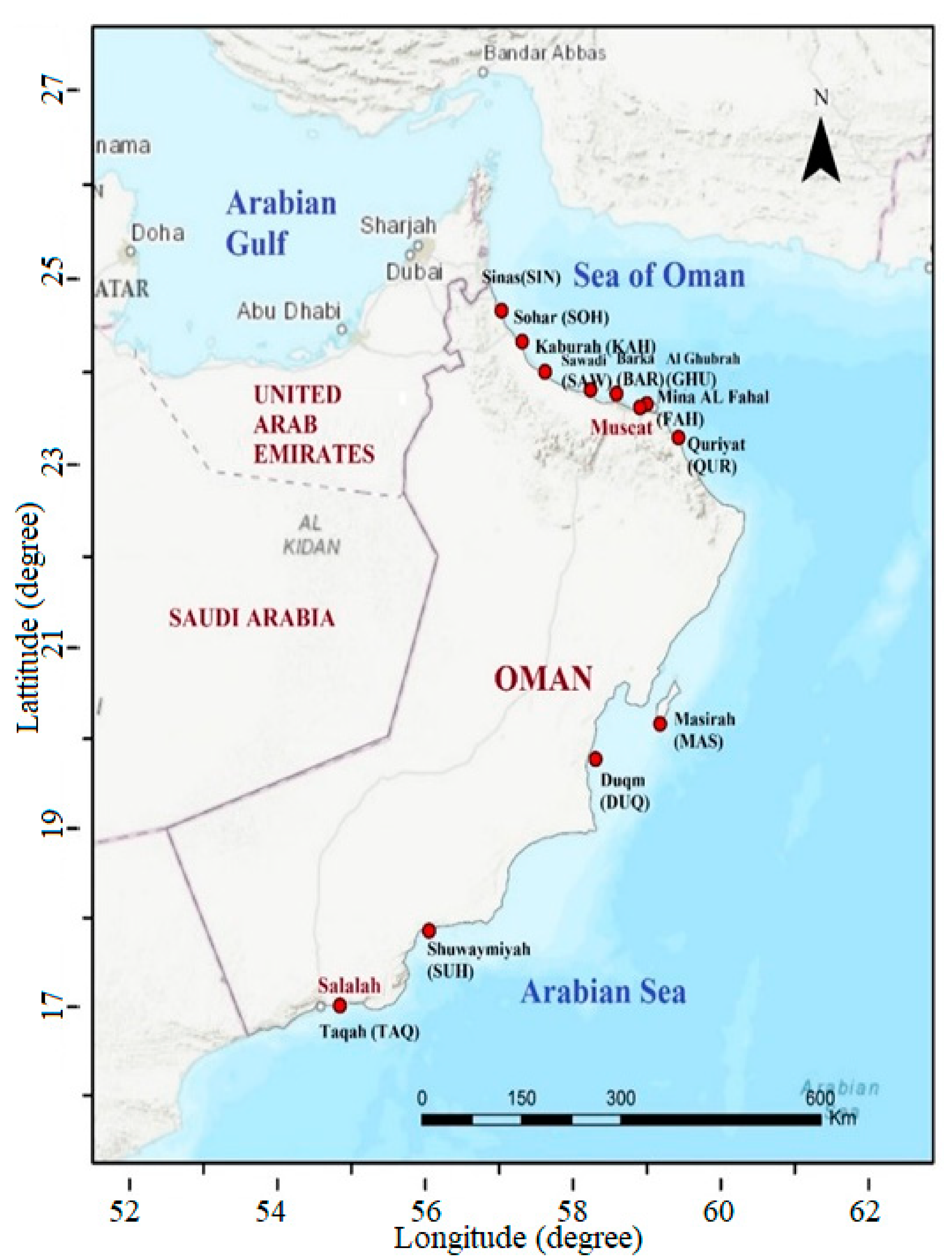
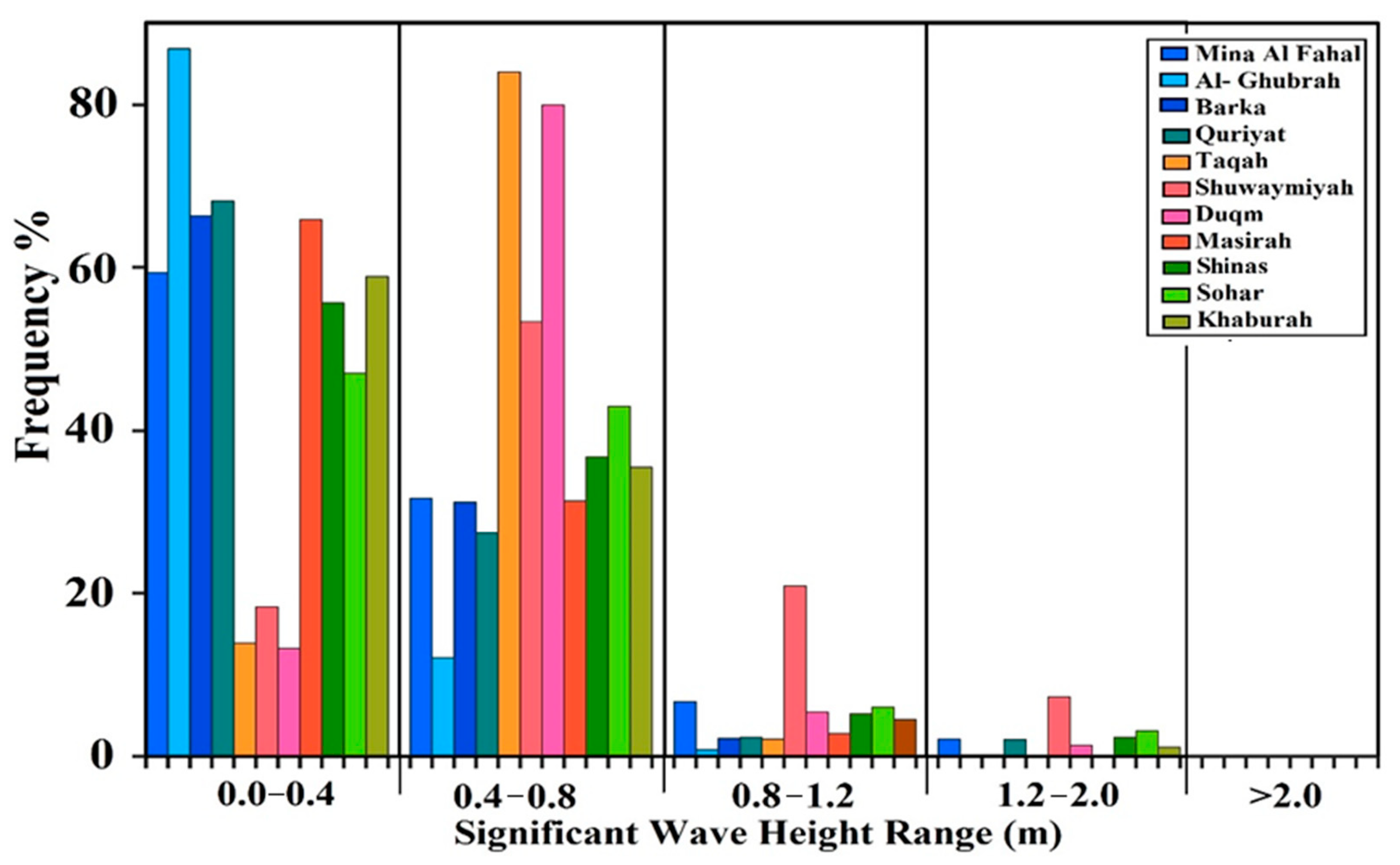
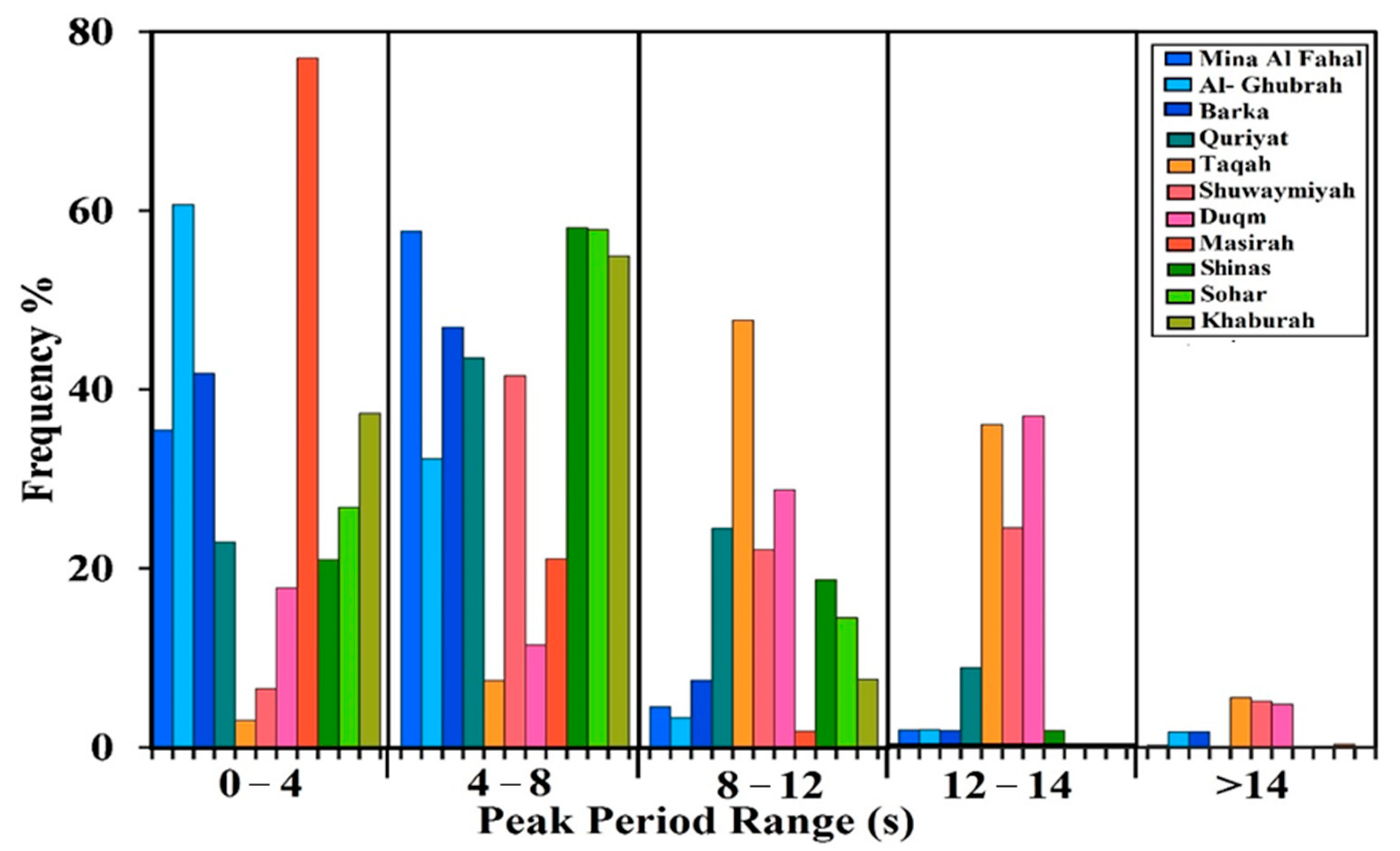
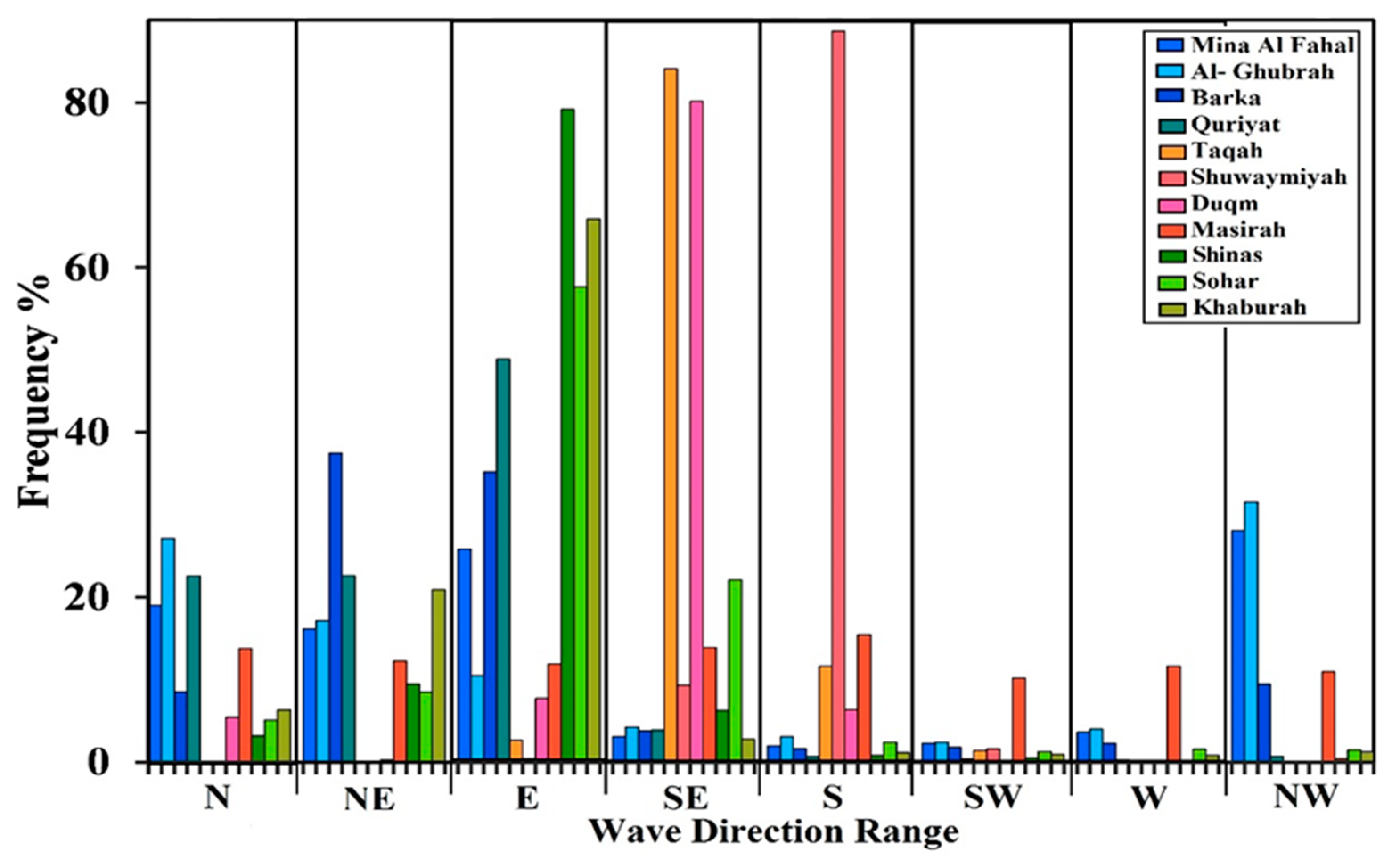
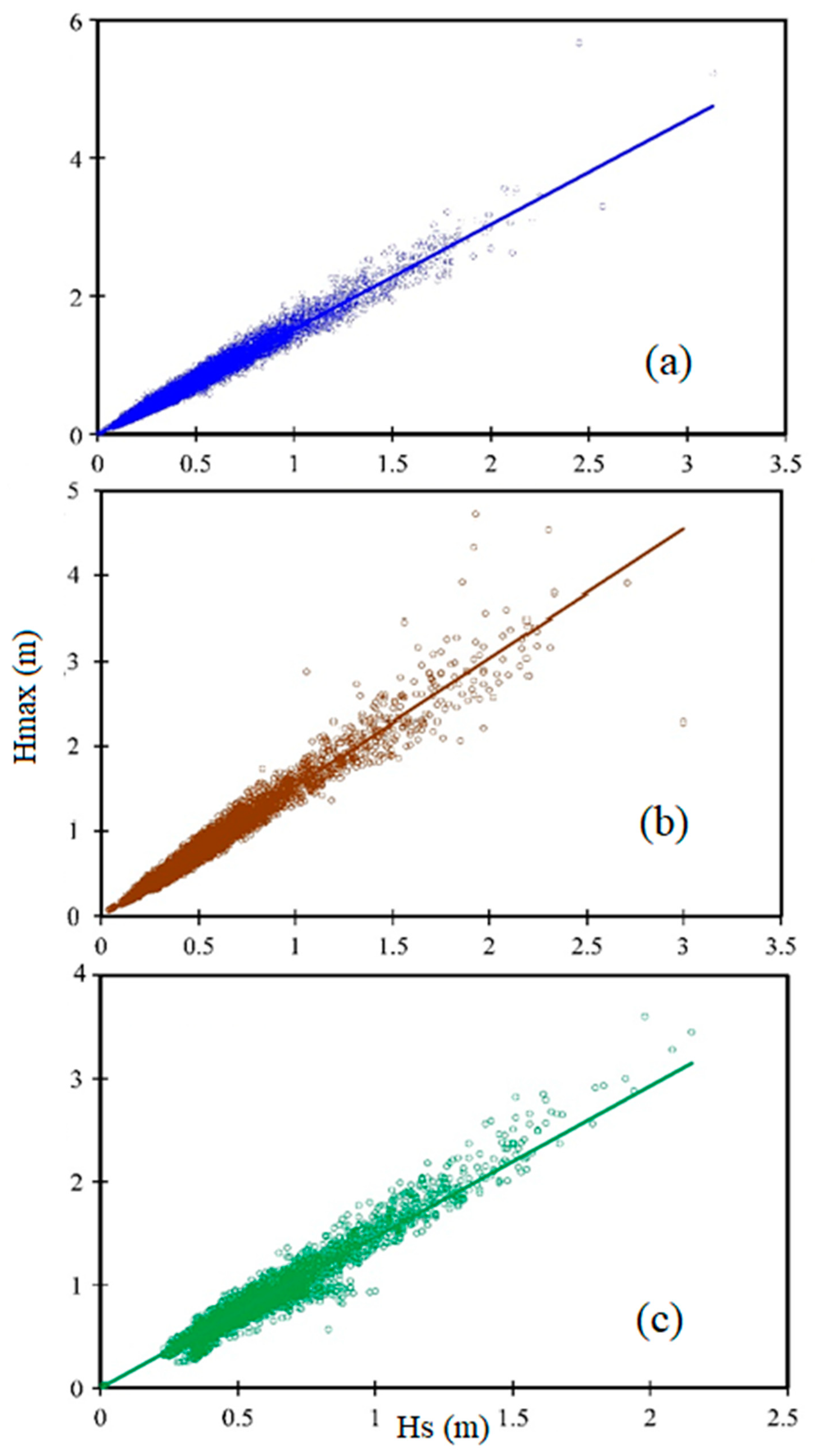
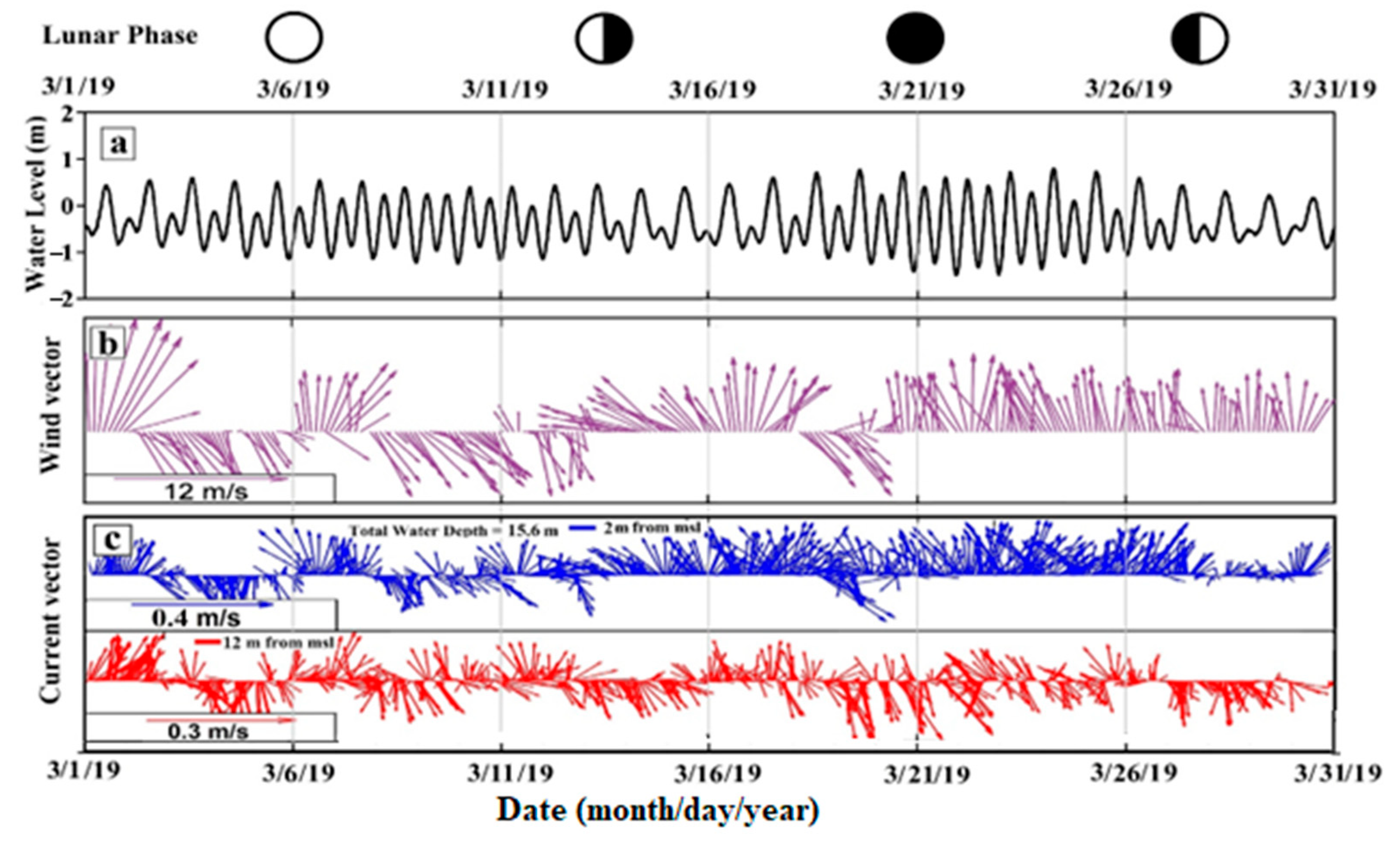
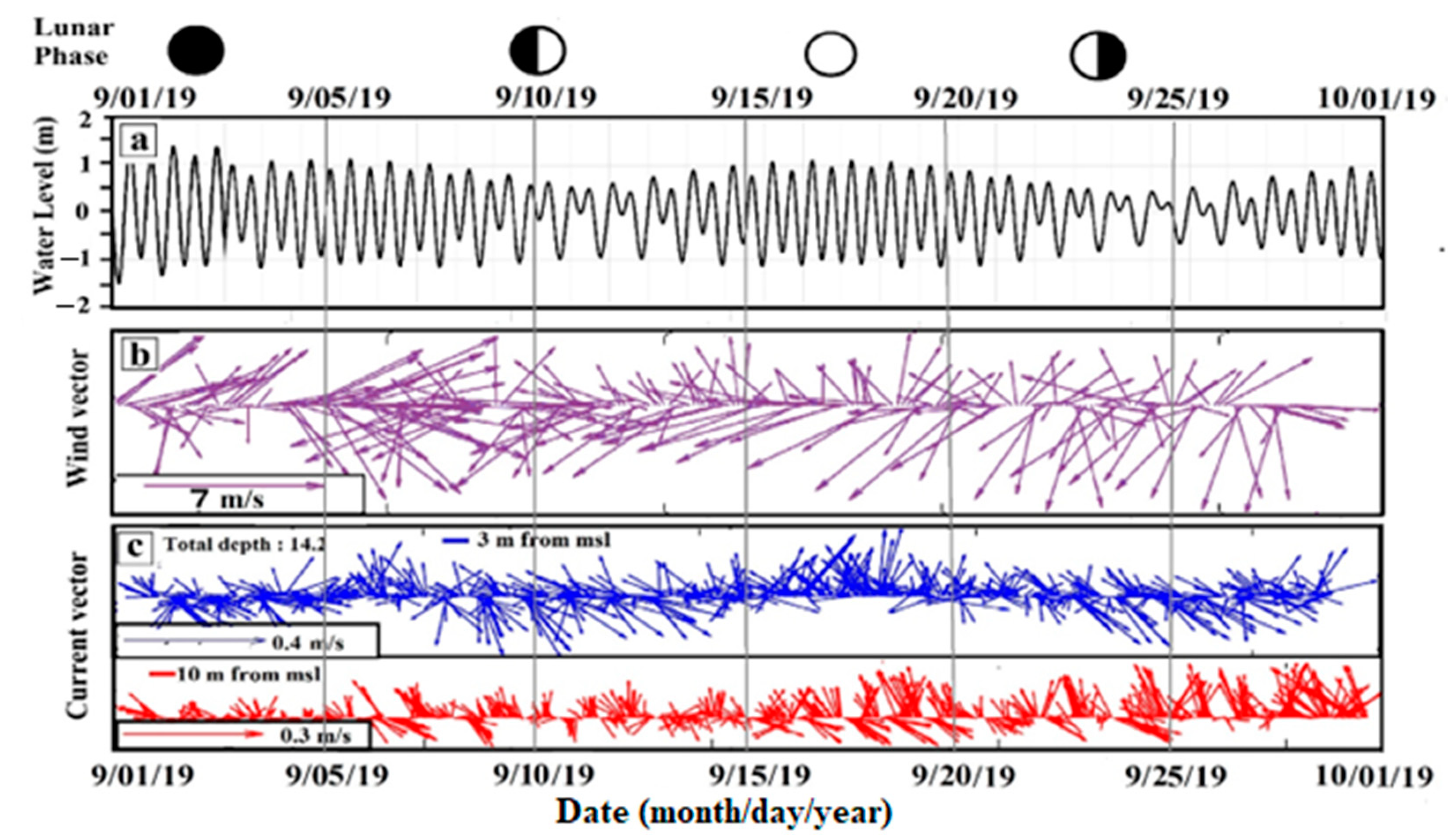
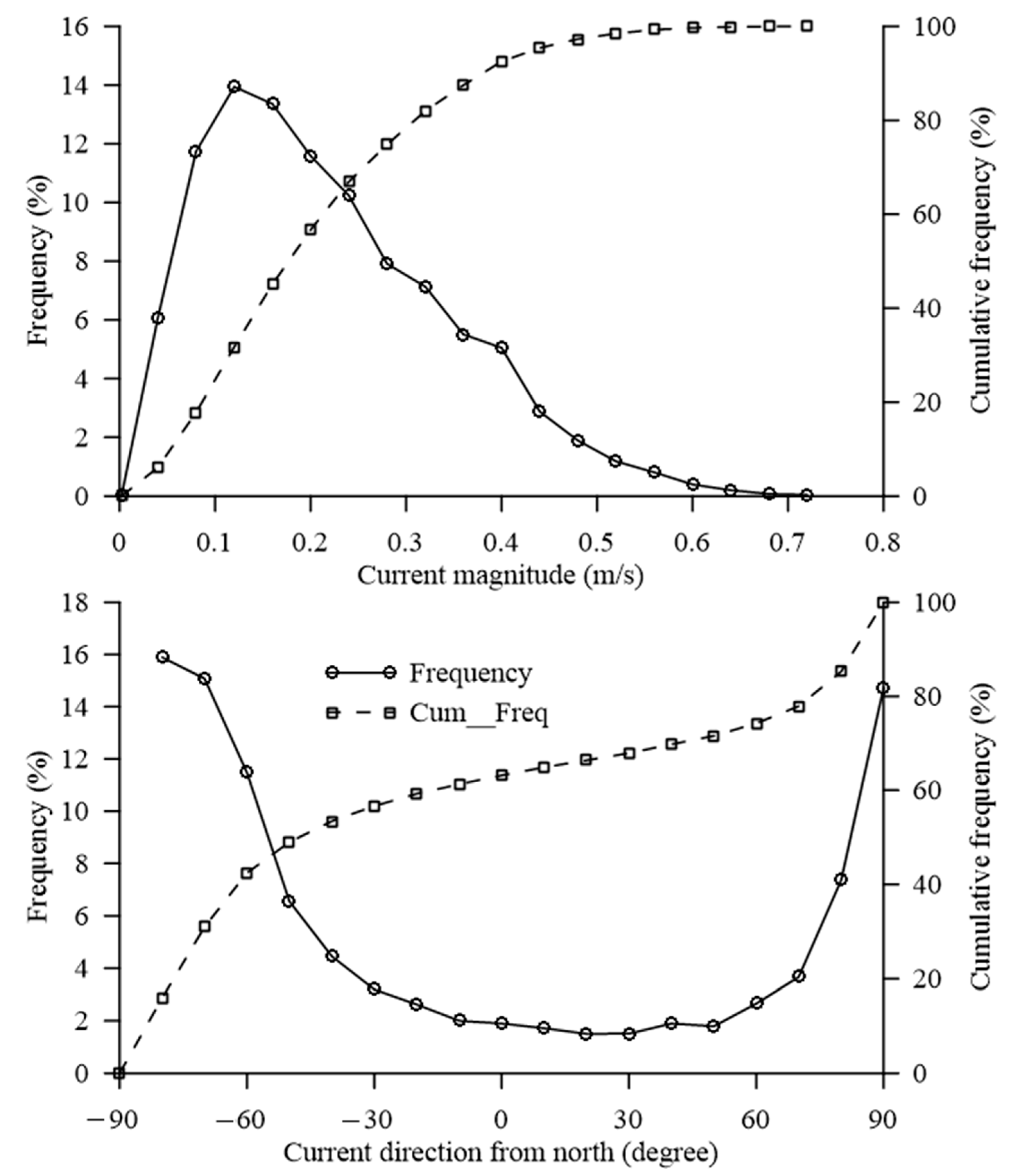
| Station ID | Station Location | Latitude (°N) | Longitude (°E) | Depth 1 (m) | Duration 2 (Days) |
|---|---|---|---|---|---|
| S1 | Mina Al Fahal | 23°39.562′ | 58°29.950′ | 20.6 | 265 |
| S2 | Al Ghubrah | 23°37.277′ | 58°24.405′ | 14.3 | 71 |
| S3 | Barka | 23°46.200′ | 58°5.172′ | 22.5 | 189 |
| S4 | Quriyat | 23°17.742′ | 58°55.560′ | 16.4 | 64 |
| S5 | Taqah | 17°0.943′ | 54°20.669′ | 18.6 | 60 |
| S6 | Shuwaymiyah | 17°51.410′ | 55°33.071′ | 17.9 | 61 |
| S7 | Duqm | 19°46.319′ | 57°48.313′ | 15.6 | 61 |
| S8 | Masirah | 20°9.581′ | 58°40.734′ | 19.3 | 61 |
| S9 | Shinas | 24°39.746′ | 56°32.032′ | 16.0 | 156 |
| S10 | Sohar | 24°19.774′ | 56°48.772′ | 14.2 | 154 |
| S11 | Khaburah | 24°0.257′ | 57°7.205′ | 15.1 | 135 |
| Station ID | Station Location | Return Period (Year) | ||||
|---|---|---|---|---|---|---|
| 5 | 10 | 20 | 50 | 100 | ||
| S1 | Mina Al Fahal | 0.66 | 0.88 | 1.1 | 1.38 | 2.56 |
| S2 | Al Ghubrah | 0.42 | 0.57 | 0.69 | 0.9 | 2.57 |
| S3 | Barka | 0.57 | 0.8 | 1.01 | 1.28 | 3.13 |
| S4 | Quriyat | 0.58 | 0.79 | 0.98 | 1.24 | 1.89 |
| S5 | Taqah | 0.77 | 1.03 | 1.53 | 1.8 | 1.95 |
| S6 | Shuwaymiyah | 1.06 | 1.46 | 1.85 | 2.22 | 2.97 |
| S7 | Duqm | 0.85 | 1.2 | 1.55 | 1.63 | 1.67 |
| S8 | Masirah | 0.79 | 1.08 | 1.61 | 1.92 | 1.99 |
| S9 | Shinas | 0.79 | 0.99 | 1.08 | 1.42 | 2.03 |
| S10 | Sohar | 0.87 | 1.04 | 1.20 | 1.51 | 3.31 |
| S11 | Khaburah | 0.68 | 0.85 | 1.02 | 1.19 | 1.88 |
| All stations | 0.71 | 0.92 | 1.15 | 1.32 | 3.31 | |
Disclaimer/Publisher’s Note: The statements, opinions and data contained in all publications are solely those of the individual author(s) and contributor(s) and not of MDPI and/or the editor(s). MDPI and/or the editor(s) disclaim responsibility for any injury to people or property resulting from any ideas, methods, instructions or products referred to in the content. |
© 2023 by the authors. Licensee MDPI, Basel, Switzerland. This article is an open access article distributed under the terms and conditions of the Creative Commons Attribution (CC BY) license (https://creativecommons.org/licenses/by/4.0/).
Share and Cite
Sana, A.; Chitrakar, P.; Baawain, M.; Al-Mamun, A. Baseline Measurements of Waves and Currents along the Coast of Oman. J. Mar. Sci. Eng. 2023, 11, 1711. https://doi.org/10.3390/jmse11091711
Sana A, Chitrakar P, Baawain M, Al-Mamun A. Baseline Measurements of Waves and Currents along the Coast of Oman. Journal of Marine Science and Engineering. 2023; 11(9):1711. https://doi.org/10.3390/jmse11091711
Chicago/Turabian StyleSana, Ahmad, Prerana Chitrakar, Mahad Baawain, and Abdullah Al-Mamun. 2023. "Baseline Measurements of Waves and Currents along the Coast of Oman" Journal of Marine Science and Engineering 11, no. 9: 1711. https://doi.org/10.3390/jmse11091711
APA StyleSana, A., Chitrakar, P., Baawain, M., & Al-Mamun, A. (2023). Baseline Measurements of Waves and Currents along the Coast of Oman. Journal of Marine Science and Engineering, 11(9), 1711. https://doi.org/10.3390/jmse11091711








